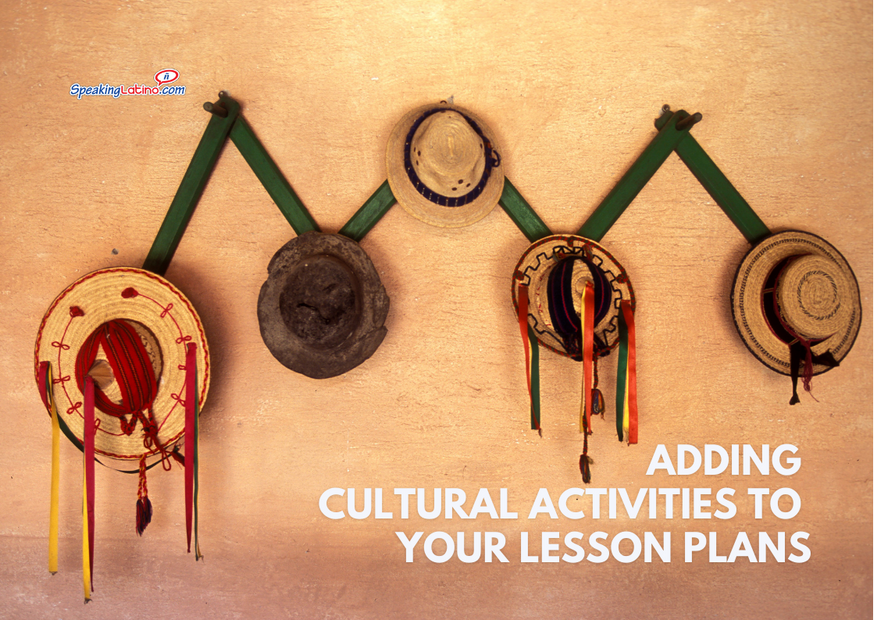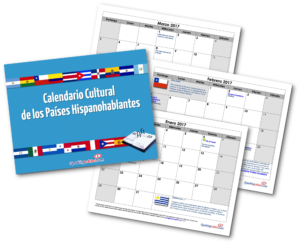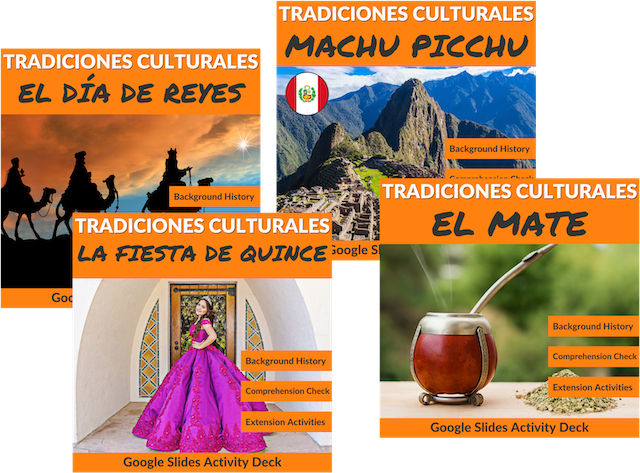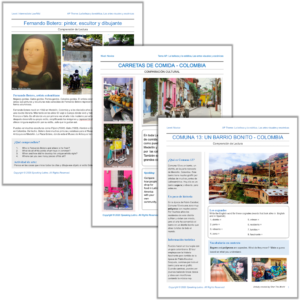You’ve got the planning down, but now, how do you add Spanish culture and traditions to your lesson plans?

Spanish cultural lesson plans can be the trickiest to create, especially when under pressure to complete the language portion of the class. Think of it this way – culture is language and language is culture, so interesting Spanish culture topics are essential for the course. Communication is not just the words – knowing how and why people interact in that country is also important for communicating in the target language properly.
Culture can be as simple as learning the correct register of voice to use when speaking with a stranger versus your friend. What students are always asking for more of is the actual customs and traditions of a Spanish-speaking country. Spanish culture activities can be, and usually are, the hook that intrigues the students to learn more about the language. Keep on reading to check how you can incorporate Spanish culture and traditions into your classes!
1. Have a Cultural Calendar

In 2015, I created a Cultural Calendar, and it was a game changer. The legwork was done the first year, but in the following years, updating it was quick. In a Word document, I identified all the major holidays and celebrations from the Spanish-speaking countries with a link to an article, video, or information to share with the students. This calendar keeps me updated throughout the school year. For example, Día Nacional del Mate on November 30th, Fiestas Patrias de Chile on September 18th, Indigenous People Day, and so on.
I send a free copy of the Cultural Calendar via email every month, so be sure to add your information here to get it. Plus, there are instructions to add the electronic version to your Google Calendar and make it easier to be up to date with Spanish cultural events.
2. Cultural Presentations with Quick Activities

I also have a library of introductory cultural presentations about many topics to use throughout the year. Some ideas came from the Cultural Calendar holidays and celebrations, but others are about traditions. These presentations are in Spanish for intermediate-advanced classes and in English if I want to explain the topic to novice students. Each presentation also has a video and a couple of slides with comprehension activity.
I have identified and created about 47 cultural Google slides here.
3. Use Authentic News Articles and Media

When I see a news article, blog, video, or media from around the Spanish-speaking world that may interest students, I create 3 worksheets with Spanish cultural activities around it: scaffolded for novice, intermediate, and advanced students.
I think about what tasks students at each level can accomplish with the same resource. While some of these Spanish cultural projects may be relevant at specific times of the year, these activities are not tied to any lesson in particular.
If you want to check them out, there are more than 75+ scaffolded Spanish cultural activities in my library.
The only scaffolded Spanish culture lesson plan that for sure should go first is this audiovisual interpretative activity about cultural appropriation and cultural assimilation.
4. Host a Fair
For novice levels of Spanish, try sticking to general Spanish culture topics for presentations and activities, like holidays, food, or music. This will allow you to explore and touch upon many countries and give the students a sampling of what is actually out in the world.
A fantastic way to incorporate these topics is to host a Feria de comida, or a Feria de música. These “fairs” break the normal classroom routine, piquing students’ interest, but also allowing them to really explore Spanish culture and traditions and get a basic idea of how each Spanish-speaking country is similar in their festivals, culture and celebrations and how they are different.
These types of Spanish culture lesson plans usually take two days to complete the actual fair, but it can be pretty easy to integrate them into your normal classroom activities. Here are some tips:
- Be sure that the topic of the fair coincides with the unit you are working on. This way, there is not a jarring change when you have the students work on their country during class.
- Giving them time in class to work on Spanish cultural projects is usually beneficial. Don’t overdo it because then the students take advantage of the time given.
- If it’s possible you could have the students start on their cultural fair project the first week of the unit. Give them a class period the first week and then maybe 15-20 minutes each week after (until the actual fair).
- There are multiple Spanish culture project ideas to choose from, so go with what is the most comfortable for you and your class.
During the actual fair, split the class into two (or more) groups – a group that presents one day and the other group that presents the next day. You can have the groups present to the whole class, or you can do a round–robin presentation. The round-robin is where all the presentation groups are set up and presented to a small group of students for about 6-10 minutes (depending on your class period’s length).
After that time is up, the small groups will move to the next presentation, and the presenters will present again for the allotted time. The only downfall is that the students presenting will not get to hear the other presenters.
5. Read Books With References to Cultural Activities in Spain or South/Central America
Choose your favorite book that has references to Spanish cultural events or customs, and tell your students to read at least a chapter or two.
Books for Kids
When you plan to conduct a lesson about Spanish culture for kids, you can use such books as:
Paletero Man, by Lucky Diaz
Lucky Diaz is a Latin Grammy-winning musician famous for playing bilingual indie music for kids together with his wife. In his book, the narrator searches for the ice pop truck all around his community. Little Spanish readers can encounter simple words and phrases throughout the book, as well as cultural references that can facilitate the introduction to Spanish culture topics.
Alma and How She Got Her Name, by Juana Martinez-Neal
This book will help you to explain the sentimental meanings behind long Hispanic names. It tells the story of Alma Sofia Esperanza José Pura Candela, who is embarrassed by her long name and asks her dad about it. This book is full of warmth and helps children understand the beauty of Hispanic cultural heritage.
Too Many Tamales, by Gary Soto
In this book, we have a girl called Maria who is helping her family prepare tamales for Christmas Eve dinner. She accidentally loses her mom’s stunning diamond ring and asks her cousins to help her find it.
Thanks to this story, children not only learn that it’s better to tell the truth than to try to hide a problem but are also introduced to Hispanic food and other traditions associated with Christmas, so it is perfect for your last class before the Christmas break.
Books for Adults
Here are examples of books that can inspire Spanish culture project ideas for classes with adult students:
How the García Girls Lost Their Accents, by Julia Alvarez
This novel presents a family living in the Dominican Republic in the 1960s who needed to leave their country due to political reasons. We see them trying to keep their Dominican traditions while settling in the chaos of New York City. It is not only a good starting point for introducing cultural topics but also for discussing the topic of Hispanic immigrants adapting to living abroad while maintaining their original heritage.
Like Water for Chocolate, Laura Esquivel
This is the story of an all-female family living in Mexico, focusing on the youngest daughter, who tries to become more independent and searches for her true love.
Every chapter of this book starts with a Mexican recipe, so it is great to implement it in your cultural classes associated with local food.
The House on Mango Street, by Sandra Cisneros
The main protagonist of this novel is a girl from a Mexican-American family who goes through a journey from being ashamed of her Hispanic heritage to accepting it and finding herself.
It is another excellent story not only mentioning Hispanic traditions but also showing why they are so important to the community.

6. Incorporate Songs Referring to Interesting Spanish Culture Topics
Hispanic music is so characteristic that it basically has to be incorporated into Spanish cultural projects if you want your students to understand the Spanish-speaking community better.
You have many opportunities, and you can choose a typical Pop Latino song or dig deeper and select Indigenous music or other more marginalized voices.
It’s definitely a good idea to find clean songs suitable for Spanish culture lesson plans that mention various traditions, customs, holidays, or local cuisines.
It can be difficult and time-consuming to search for such music on your own, so we have prepared a free Spanish song list. As all the songs have useful annotations, you will know what they are about and what Spanish cultural activities they are most suitable for.

7. Introduce Spanish Slang and Idioms
Learning local slang and idioms present in the Spanish language is crucial for both developing communication skills and discovering the cultural heritage. They are a significant part of every culture and make the speech more vivid and natural. On top of that, it helps to avoid misunderstandings, which could appear if an idiom used by a native speaker was understood literally.
To make it easier for you to organize such a class, we have prepared a set of printable Spanish sayings. As they have both Spanish and English explanations along with cartoonish illustrations, they can be easily understood and memorized by your students.
Apart from that, we have published useful e-books serving as slang dictionaries of various local Spanish variants. They will help you introduce slang expressions from a chosen country to your classes and familiarize your students with a particular country better.
8. Explore Local Myths and Folklore
Exploring local folklore and myths is a wonderful way to learn more about the culture of a chosen country. Try to find traditional stories and legends that can be fascinating to discover no matter the age.
Such folk tales are often associated with the history of a region, which may create an opportunity to introduce historical elements to your classes as well.
What’s more, they sometimes also try to explain natural phenomena, so it helps to understand how people from the past tried to understand something that was beyond their comprehension at that time. Even though nowadays there is a scientific explanation for that, it happens that the old cultural beliefs still affect people’s thinking (especially when it comes to superstitions).
You can divide your students into groups and ask them to prepare presentations on the folklore and myths associated with a particular Spanish-speaking country. It will be enjoyable and engaging for them and will help them to acquire new vocabulary and cultural knowledge!
The Final Note
Either way, the students are learning valuable information about the Hispanic world’s culture and traditions in a fun and interesting way. Latino countries and Spain activities for the classroom will make your lessons more engaging and help your students acquire new vocabulary faster and with less effort.

What’s even more important, they will allow them to understand the culture of the Hispanic world better and avoid misunderstandings with native speakers.
Thanks to the materials available on our website, teaching Spanish can be easier, more enjoyable, and more effective. Download them now!